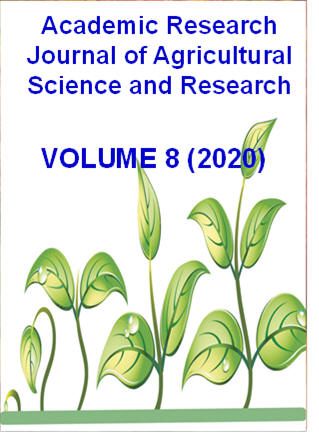|
ISSN: 2360-7874 |
Academic Research Journal of
Agricultural Science and Research |
|||||||||||||||||||
|
Vol. 8(5), pp. 432-446, June 2020 Research Effect of Organic and Inorganic Fertilizers on Selected Soil Properties Yield of Bread Wheat (Triticum aestivum L.) in Lume District East Shoa, Ethiopia
Mekonnen Workineh1*, Samuel Feyissa2 and Ayele Akuma3
1Adami Tulu Agricultural Research Center, P.O. BOX. 35 Batu Ethiopia 2School of Natural Resource and Environmental Science, Haramaya University, P. O. Box 138, Dire Dawa, Ethiopia.
Accepted 17 June 2020
Soil fertility depletion is one of the major limiting factors for depletion of soil properties and reduction in grain yield, in the study area. As a result, inorganic fertilizers are commonly supplied to the soil. However, continuous and sole use of inorganic fertilizers may lead to deterioration in soil chemical and physical properties. Therefore, the study was conducted to investigate the integrated use of organic and inorganic fertilizers on selected soil properties, in Lume district, East Shoa Zone, during 2018 cropping season. The organic sources used were compost and vermicompost and urea and NPS where used as inorganic of fertilizers. The treatments consist of:- T1=5.64 t/ha compost, T2=5.68 t/ha vermicompost, T3=100% recommended NPS + urea fertilizers, T4=50% recommended NPS+urea fertilizers+2.82t/ha compost, T5=50% recommended NPS+urea fertilizers+2.84 t/ha vermicompost, T6=No fertilizers (control).The experiment was laid out as a randomized complete block design replicated three times per treatments. Data were collected on, selected soil properties before treatment application and after harvesting and on wheat gain yield. Economic analysis was also performed by estimating the costs of alternative uses of organic and in organic fertilizers as well as grain yield prices. The results showed that the application of organic fertilizer in combination with 50% recommended rates of NPS+ urea significantly improves most of the soil physicochemical properties, over the application of 100% mineral NPS alone and the control. The application of 2.84 t/ha vermicompost in combination with 50% recommended rates of NPS+ urea fertilizers increases soil organic carbon content by 41%, total nitrogen by 22%, available P by 15. 40%, available K by 36.14% and 0.5t/ha over the application of 100% recommended rate of inorganic NPS alone. It can be concluded that the application of 2.84 t/ha vermicompost with 50% recommended rate of inorganic NPS fertilizers has maximum rate of return and can improve soil fertility status than other treatments. This experiment has to be repeated over seasons and locations to make conclusive recommendation for the study area.
Key Words: - Combined, Compost, Nitrogen, Phosphorous, Soil, Soil Properties
How to cite this article (APA Style): Mekonnen W., Samuel F., Ayele A (2020). Effect of Organic and Inorganic Fertilizers on Selected Soil Properties Yield of Bread Wheat (Triticum aestivum L.) in Lume District East Shoa, Ethiopia. Acad. Res. J. Agri. Sci. Res. 8(5): 432-446
|
|||||||||||||||||||
